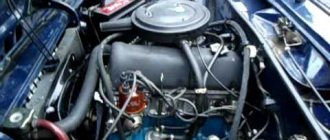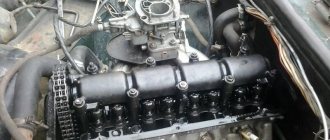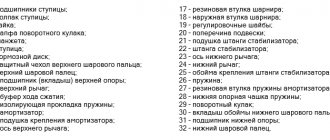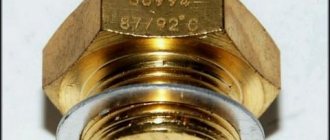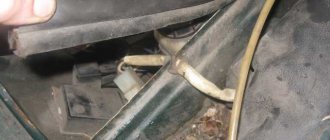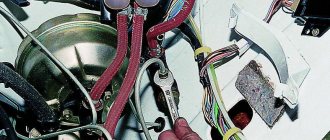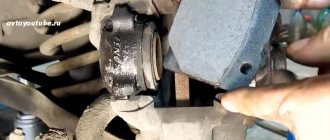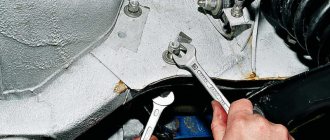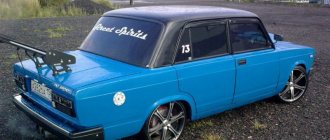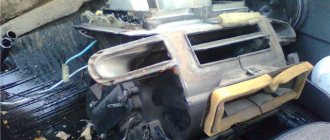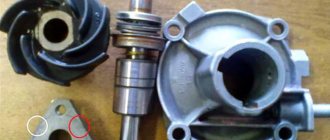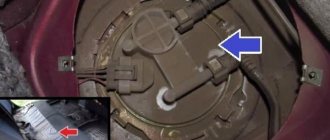↑ VAZ 2106 engine compartment photo
- – radiator;
- - accumulator battery;
- – suction pipe;
- – air filter housing;
- – oil filler plug;
- – vacuum brake booster;
- – brake system reservoir;
- – hydraulic clutch release reservoir;
- – expansion tank of the cooling system;
- – washer reservoir;
- - ignition coil;
- – radiator cap (plug);
- – electric fan;
- – upper radiator hose;
- – breaker-distributor;
- – cylinder head cover.
How to light the engine compartment video
↑ Engine
The car is equipped with a gasoline, four-stroke, four-cylinder, in-line, eight-valve engine with an overhead camshaft.
- The power supply system is carburetor.
- The operating order of the cylinders is: 1–3–4–2, counting from the crankshaft pulley.
↑ Differences between VAZ-2103 and VAZ-2106 engines
The VAZ-2103 engine differs from the VAZ-2106 engine in its smaller cylinder diameter (76 mm versus 79) and, accordingly, the cylinder block, the size of the pistons and piston rings, as well as the cylinder head gasket.
The cylinder heads of both engines are the same and their parts are interchangeable. The engine cylinders are arranged vertically in one row and combined into a block.
A block head common to all cylinders is installed on top of it. The bottom of the cylinder block is covered with a stamped steel pan, which also serves as a container for oil.
The pistons have two compression rings and one oil scraper ring. The crankshaft rotates in five bearings in the cylinder block. From the pulley at its front end, a V-belt drive drives the generator and coolant pump located on the right side of the engine.
In the front part of the engine there is a drive for the camshaft and a drive shaft for auxiliary units: ignition distributor, fuel and oil pumps. The drive is carried out by a double-row bush-roller chain.
On the right side of the engine, in addition to the generator, there is an exhaust manifold, starter and intake pipe with a carburetor and air filter. On the left side there is an oil filter.
Directions in work
Car modernization - tuning, is divided into 2 sections or streams depending on the specification:
- External tuning of VAZ 2106 . This applies to both interior and exterior. Here you will have to deal less with technological components.
- Modernization of technical characteristics - improvement of the engine, exhaust, fuel system, suspension. Do-it-yourself VAZ technical tuning will be a useful and simple modernization school for beginners.
It is quite possible to do car tuning yourself. To do this, you need a desire to improve your vehicle, tools and some practical tips that will help you create an exclusive car model.
Do-it-yourself tuning 2106 is a relatively simple process, which is determined by the simplicity of the design of domestic cars. Even a beginner who is very far from fashionable tuning trends and technical intricacies can master it. At the same time, tuning VAZ 2106 always causes delight and admiration of others, and gives the owner power and an improved level of comfort. With what might happen, you can look at the photo of the VAZ 2106 tuning.
↑ Suspension
To install the engine assembly with gearbox and clutch, a three-point suspension scheme is used. The two front supports are located on either side of the cylinder block and are attached to the cross member of the vehicle's front suspension. The rear support is located on the gearbox and rests on a cross member fixed under the floor of the body.
The elastic cushions of the front supports consist of rubber with vulcanized steel washers and mounting bolts. To increase the rigidity of the supports, there are springs in the central hole of the cushions, supported by insulating rings, and to soften impacts, rubber-metal buffers are located inside the springs. The cushions are attached to the brackets using intermediate plates. The right cushion is protected from heating from the side of the exhaust pipe of the mufflers by a protective casing.
The rear support is also rubber-metal, it consists of three steel plates with rubber separating them. The middle plate is attached to the gearbox, and the outer plates are attached to the cross member of the rear engine mount. Steel spacer bushings are placed between the crossbar flanges to protect the flanges from deformation when tightening the fastening bolts.
What are they needed for
The name “drainage holes” speaks for itself. They are designed to drain rainwater, condensation or moisture after washing. Automakers know where water can most often collect and have prudently made technological holes at the lowest points of these places.
In some cases, they are large and connected to the street by pipes. In other cases, these are simply holes in the metal elements of the body. If they were not there, moisture would accumulate in the blind cavities of the car. They would begin to rot from the inside. This is witnessed by cars with through corrosion in the lower part of the doors, sills and fenders. It seems that there is no chip, but the “red” has already appeared.
We will analyze in detail for each popular VAZ model where they are located. In most cases, the location of the drainage holes on VAZ models is the same, but there are nuances. Let's start with the "classics".
To Contents...
Advertising:
↑ Cylinder block
The cylinder block is made by casting from special high-strength cast iron. The holes for the cylinders are bored directly in the block and additional inserts (liners) are not used in the cylinders. To obtain a special profile and surface cleanliness, the cylinders are honed. By diameter, cylinders are divided into 5 classes every 0.01 mm, designated by the Latin letters A, B, C, D and E. The class of each cylinder is marked on the bottom plane of the cylinder block.
The holes for the main bearings of the crankshaft are bored together with the bearing caps. Therefore, they are not interchangeable either with each other or with the covers of other cylinder blocks. In order not to confuse the lids, markings are made on them. The bearing caps are attached to the cylinder block with self-locking bolts, the replacement of which with any other bolts is unacceptable.
The auxiliary drive shaft rotates in two bushings pressed into the cylinder block. The front bushing is steel-aluminium, and the rear bushing is metal-ceramic, bronze-graphite. Spare parts are supplied with bushings of nominal and repair sizes with an internal diameter reduced by 0.3 mm.
↑ Piston
The pistons are cast from aluminum alloy. To improve its wearability to the cylinder walls, the outer surface of the piston is coated with a thin layer of tin. To compensate for uneven thermal expansion, the piston skirt has a complex shape. It is conical in height and oval in cross section. Therefore, it is necessary to measure the piston diameter only in a plane perpendicular to the piston pin and at a distance of 52.4 mm from the piston bottom.
Based on the outer diameter, pistons (as well as cylinders) are divided into five classes: A, B, C, D and E, every 0.01 mm, and according to the diameter of the hole for the piston pin, they are divided into three categories, every 0.004 mm. The category is indicated by paint on the end (the first is blue, the second is green, the third is red). The piston class (Latin letter) and category (number) are marked on the piston bottom.
Spare parts include pistons of classes A, C, E, which are quite sufficient to select a piston for any cylinder, since pistons and cylinders are divided into classes with some overlapping sizes.
The hole for the piston pin is shifted from the axis of symmetry by 5 mm to the right side of the engine. Therefore, there is a mark on the piston in the form of the letter P for the correct orientation of the piston in the cylinder. The mark should face the front of the engine.
Since 1986, repair size pistons for all VAZ engine models have been manufactured with an outer diameter increased by 0.4 and 0.8 mm. Until 1986, repair size pistons for engines 2103 and 2106 were produced with an increase of 0.4; 0.7 and 1.00 mm.
The pistons of engines 2103 and 2106 differ only in size (diameter).
The piston rings are made of cast iron. Top compression ring with barrel-shaped chrome-plated outer surface. The lower compression ring is scraper type, phosphated.
The piston pins are pressed into the upper head of the connecting rod and rotate freely in the piston bosses. According to the outer diameter, the fingers are divided into three categories every 0.004 mm.
The category of the finger is marked on its end with the appropriate color:
- 1st – blue,
- 2nd – green,
- 3rd – red.
The connecting rod is steel, forged. The lower head of the connecting rod is detachable; connecting rod bearings are installed in it. The connecting rod is processed together with the cap and therefore they are not interchangeable with the caps of other connecting rods. To avoid mixing up the connecting rod caps during assembly, the connecting rod and its cap (on the side) are marked with the number of the cylinder in which they are installed. When assembling, the numbers on the connecting rod and cap must be on the same side.
Where to begin?
You shouldn’t immediately rush to improve the engine, turning the car into a racing car. It’s better to start tuning a car 2106 with something simple - do simple operations that don’t require much effort.
The first step in upgrading the VAZ 2106 is replacing the wheels and tires. This is an effective way to attract attention. Today the market offers a huge selection of alloy wheel models. But if nothing fits, you can order the production of an exclusive set from the studio, but it will cost a pretty penny. You need to follow several recommendations to take the first step and start tuning the VAZ 2106.
- You should not install wheels with a diameter larger than 14 inches on a VAZ, as a larger diameter will reduce the car’s handling and may require modifications to the wheel arches;
- It is worth remembering that alloy wheels are not as practical as iron wheels; they are easily deformed when they fall into holes. Restoring their shape is difficult and expensive. To ensure trouble-free operation, it is better to install forged wheels, but they are quite difficult to find and they are somewhat more expensive than alloy wheels;
- It is necessary to choose the correct tire profile (tire height). This is the second designation in the tire size marking. For example, 185/65 R14. Where the designation 65 is the tire height. For VAZ, values in the range of 55–65 are best. The width of the tire is selected in accordance with the width of the rim.
Helpful advice It is recommended to start tuning the VAZ 2106 by replacing wheels and tires in order to awaken interest in further modernization, because appetite comes with eating.
↑ Crankshaft
The crankshaft is cast from high-strength cast iron and has five support (main) journals, hardened by high-frequency current to a depth of 2–3 mm. At the rear end of the crankshaft there is a socket into which the gearbox drive shaft bearing is inserted. The lubrication channels in the crankshaft journals are closed with cap plugs, which are pressed in and caulked at three points for reliability.
To extend the service life of the crankshaft, it is possible to regrind the crankshaft journals when their surfaces are worn or damaged. By grinding, the journal diameters are reduced by 0.25; 0.5; 0.75 and 1.00 mm.
The axial movement of the crankshaft is limited by two thrust half-rings installed in the cylinder block on either side of the rear main bearing. A steel-aluminum half-ring is placed on the front side of the bearing, and a metal-ceramic half-ring (yellow) is placed on the rear side.
The main and connecting rod bearing shells are thin-walled, bimetallic, steel-aluminium. The shells for the 1st, 2nd, 4th and 5th main bearings have a groove on the inner surface (since 1987, the lower shells of these bearings are installed without a groove). The central main bearing shells differ from other shells in that they lack a groove on the inner surface and are larger in width. All connecting rod bearing shells are without grooves, identical and interchangeable. Repair liners are made of increased thickness for the crankshaft journals, reduced by 0.25; 0.5; 0.75 and 1 mm.
